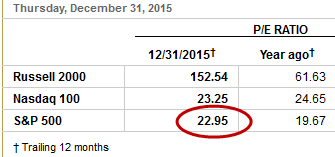John J. Xenakis
European and Wall Street stocks fall sharply, following China
The Dow Jones industrial average closed about 275 points lower, or 1.58%, for its worst start on the first day of the year since 2008. Earlier, the index fell 467 points, or more than 2.5%, temporarily on pace for its largest percent decline on the first trading day of the year since 1932. European stocks closed sharply lower, with the German DAX 4%, and the STOXX Europe 600 closing 2.5% lower.DYI Quick Comment #1: Downside market action should come as no surprise for readers of this blog for DYI has been "pounding the podium" that U.S. stocks massively overvalued. Is this the beginning of the long awaited big bear market? Only time will tell. What we do know is that the Fed's have blown their third bubble and all bubbles will eventually burst.
It appears that European and American stocks were following the Shanghai stock market on Monday. Shanghai stocks fell 5%, triggering a circuit breaker that closed trading for 15 minutes. But after lunch, stocks another 2%, and trading was quickly ended for the day. Analysts blamed the plunge on bad manufacturing data the came out on Monday.
There are concerns that closing trading is going to result in panic selling on Tuesday.
China's Shanghai stock market appeared to be in a full-fledged crash in the middle of last year. China's government responded with an almost unbelievable set of interventions -- forbidding government owned corporations from selling stocks, arresting people who "spread malicious rumors" (like "stocks are slumping), or who "meddle" in the stock market by selling stocks. In addition, Every day around 2 pm, the Chinese used government-backed funds to make huge purchases of shares in large capitalization companies. ( "2-Sep-15 World View -- China leads a worldwide stock selloff")
As I wrote last year, it's impossible for the government to cause, prevent or stop a full-fledged stock market crash. The Chinese government was able to stop the Shanghai slide last year, by intervening so thoroughly that it wasn't really a market any more, but they didn't (and couldn't) do anything about the underlying imploding bubble and except prop it up for a while. At some point, the implosion will have to continue, and it's possible that that time is now.DYI Quick Comment #2: Governments can manipulate markets up or down for far longer than most of us believe possible. As the old saying goes "markets can stay far more irrational than you can stay solvent."
But over time Mr. Market WILL HAVE HIS WAY! What drives Mr. Market is valuations and his never ending quest to regress back down or back up to the mean. Today on a price to dividend basis stocks are 104% above their average. Just to arrive back to the average(4.40% dividend yield) would require the market to be cut 51%! Mr. Market in order to maintain the average will need to drop the market below the mean so he can begin his journey back up to the mean and surpass it. This journey will be many years in the making and for those who understand valuations very profitable.
I listened to numerous analysts on Monday explain why Wall Street stock fell so sharply. A typical opinion was the following (paraphrasing): "The Chinese plunge shouldn't have happened, because the bad manufacturing data was really expected. For the same reason, the Wall Street plunge was only temporary, and once investors look at the fundamentals and how cheap stocks are, 2016 should be a very good year for the stock market."DYI Quick Comment #3: Wall Street Mantra...Best time to buy stocks? Every day is the best time....Are stocks overvalued? NEVER!...Are stocks forever undervalued? Of course!....This is why I no longer watch any of the stock channels it is nothing more than a propaganda machine for Wall Street.
I heard several variations of that, and it's so ridiculous that it's laughable. By very careful wording, the Shanghai bubble was not mentioned at all. And Wall Street stocks are not only not cheap, but they're in a huge bubble. Needless to say, the words "bubble" and "price/earnings ratio" were not mentioned by any of the analysts on Monday.DYI Quick Comment #4: Wall Street's silent code....Don't confuse investors with the facts!
 |
As I've repeated many times, Generational Dynamics predicts that we're headed for a global financial panic and crisis. According to Friday's Wall Street Journal, the S&P 500 Price/Earnings index (stock valuations index) on Friday morning (December 31) was at an astronomically high 22.95. This is far above the historical average of 14, indicating that the stock market is in a huge bubble that could burst at any time. Generational Dynamics predicts that the P/E ratio will fall to the 5-6 range or lower, which is where it was as recently as 1982, resulting in a Dow Jones Industrial Average of 3000 or lower.DYI Quick Comment #5: DYI is no doubt a big bear. Wow is John Xenakis a mega bear. The Dow so far has peaked on May 19, 2015 at 18,312 a drop to 3000 would be decline from peak to trough of 84%! If this were to occur this would take two or three cyclical markets to complete the mean inversion(from a 1.11% div. yield[2000] to around 6%, 7% or possibly 8%).
DYI's weighted averaging formula will only begin buying proportional greater amounts of stocks once stocks past their mean dividend yield. At that time as stocks begin their ending phase for the bear market DYI will once again appear to the average person to be "out of step." Those steeped in the understanding of valuations will realize the accumulation stage where massive bargains will be obtained. The 1970's or the 1930's illustrates the accumulation stage. Once completed its off to the races with a new bull market.
The Great Wait Continues.....
Updated Monthly
No comments:
Post a Comment